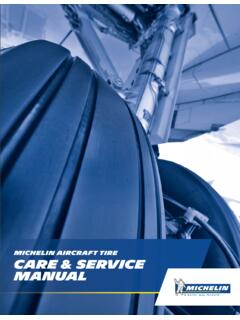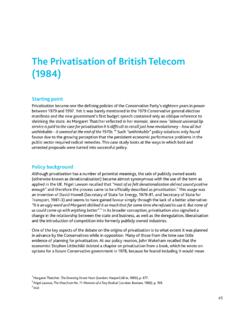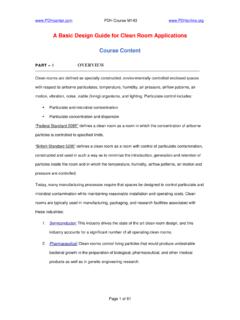Transcription of The Future of Advanced Aerial Mobility
1 The Future of Advanced Aerial MobilityWhitepaper published October 202102/52 The Future of Advanced Aerial Mobility Contributors Vertical aerospace would like to thank our whitepaper contributors for their help in drafting this Future of Advanced Aerial Mobility 1. Foreword Stephen Fitzpatrick CEO Vertical AerospaceA new form of flight is coming to our skies faster than many realise. Vertical aerospace is here to electrify VA-X4 will be flying, fully certified by 2024. The UK is well-placed to be a global leader in designing, building and deploying Advanced Air Mobility (AAM) aircraft. We have the skills, the technology, and increasing customer orders from around the world. The VA-X4 is helping to revive the legendary british aerospace industry is not flying solo.
2 The X4 depends on an expert UK ecosystem of partners. Virgin Atlantic will fly them, from major hubs like Heathrow, in airspace designed and managed by NATS, landing at existing sites and new vertiports built by Skyports. This whitepaper describes how we will work together and deliver safe, quiet, low carbon, inexpensive air transport to the s a big prize. An estimated 1 2% of GDP, thousands of highly-skilled british jobs and billions in valuable exports. Productivity will grow as congestion falls. New connections emerge, making regions and nations of the UK stronger, driving new levelling-up opportunities. New products and services will enhance lives for everyone in the UK. And for the planet as a whole, we will help the move towards Net Zero cutting carbon by reducing reliance on short-haul flights and other modes of UK can lead this transportation revolution.
3 To build and maintain that lead we need government to support. Clear, pragmatic regulation, guaranteeing safety and encouraging rapid Future is coming in for Future of Advanced Aerial MobilityContents 1. Foreword 3 2. Executive Summary 5 3. What is AAM? 8 4. Why AAM? 10 5. Forging a New Ecosystem 27 6. Use Cases 31 7. Challenges 35 8. Roadmap 50 9. About Vertical aerospace 51 10. Glossary 52 05/52 The Future of Advanced Aerial Mobility 2. Executive SummaryAdvanced Aerial Mobility (AAM) is a Future transport, enabled by electric Vertical Take-Off and Landing (eVTOL) aircraft flying from existing airports, rural locations, and new inner-city VA-X4, engineered by the UK s Vertical aerospace , is a first-generation AAM aircraft. It carries four passengers and one pilot on intercity journeys at prices comparable to rail or taxi will deliver huge economic benefits and improve british lives.
4 Journeys won t just become cheaper; they ll become easier, more direct, and cleaner. Stronger connections will help level-up Britain, bringing cities and people closer. Productivity will rise. Transport congestion will ease. The air taxi market is forecast to become a multi-billion-pound industry, and the UK Government predicts it will lift GDP by by UK is a world leader in AAM and has the chance to build on that lead. The UK can reclaim its position as an end-to-end designer and manufacturer of commercial aircraft. AAM is a high-tech, high-skill industry with enormous export potential. 88% of our current aerospace jobs are located beyond London and the South East a truly nationwide Future of Advanced Aerial MobilityLeading aviation industry players and emerging AAM pioneers are collaborating, establishing a UK ecosystem that will realise this new mode of transport and the socio-economic progress it brings.
5 Stakeholders include Virgin Atlantic, Heathrow, NATS, and new entrants like Skyports. All are developing novel infrastructure and services for this growing whitepaper introduces AAM. It is a statement of intent, outlining how commercial eVTOL services will manifest in the UK. It is for airlines, aerospace manufacturers, start-ups, investors, infrastructure providers, and policymakers. We d rather talk than write. It s here to engage and spark conversations. Here are the key topics we cover: AAM is becoming a reality faster than many expect. The past few years have seen rapid acceleration in investment and significant vehicle certification progress AAM success depends on a partner ecosystem with a common goal one single entity won t make it happen The UK is well-placed to be a leading developer and adopter of AAM technologies and products; we have a sizable domestic market and all the ecosystem partners 07/52 The Future of Advanced Aerial MobilityWe also highlight the challenges to overcome: A lack of government direction on the ambition for AAM risks leading to over complex or fragmented regulation and policy making Suitable infrastructure locations (in quality and quantity.)
6 Both urban and rural) must be made available near passenger demand Existing airspace management frameworks must evolve intelligently for the safe incorporation of eVTOL aircraft The british public must be brought along as this new mode of transport takes offVertical aerospace is looking forward to collaborating with emerging private sector partners and UK public authorities to surmount any obstacles. The lessons learned and successes in Britain will become the roadmap for similar ecosystems around the world. 08/52 The Future of Advanced Aerial Mobility 3. What is AAM?Aviation is on the verge of a new revolution, one set to transform the industry just as Whittle s jet engine did ninety years ago. Tomorrow s revolution is propelled by electric motors, energy storage, lightweight composites, digital technologies, and systems integration.
7 They enable an emerging class of electric and hybrid aircraft to operate in both urban and regional environments. The growing maturity of these technologies means clean sheet aircraft design, with hitherto unseen performance re on the cusp of an Advanced Aerial Mobility (AAM) era. A form of transport that makes passenger and cargo missions viable to and from locations that were until now impractical or uneconomical to serve by vehicles enabling these flights will typically be driven by an electric powertrain, powered by batteries or green energy sources. They will be capable of Vertical Take-Off and Landing (VTOL) or Short Take-Off and Landing (STOL). First-generation aircraft will be piloted, paving the way for increasingly automated and potentially autonomous new generation aircraft design bridges the gap between communities separated by inconvenient public transport or impassable terrain, facilitating new regional networks.
8 Because, unlike helicopters, they are safe, clean, and quiet, VTOLs will deliver huge benefits for densely populated cities too more convenience and less congestion. Urban Aerial Mobility (UAM) will provide the air transport links closer to passenger demand in the city rather than beyond city this whitepaper we use Vertical aerospace s VA-X4 to illustrate the capabilities of the AAM ecosystem and performance characteristics of a first generation eVTOL aircraft. Vertical aerospace is a leading designer and manufacturer of AAM vehicles and has the most conditional pre-orders of any OEM worldwide. Vertical will certify the VA-X4 in 2024 and deliver aircraft to launch customers such as Virgin Atlantic the following Future of Advanced Aerial Mobility 1 Lufthansa Innovation Hub AAM Investment DashboardAAM operations will begin trials in early adopter jurisdictions over the next 2 4 years.
9 Commercial passenger and cargo operations are expected to begin from 2025. The pace of investment in the AAM sector has accelerated in recent years, with at least US$ billion of capital flowing to eVTOL aircraft manufacturers and AAM infrastructure and solution providers in 2020 and Disclosed AAM Sector Investment (2013 2021) $ (billions)AAM-fuelled change will be profound and far-reaching. Transportation, emergency response and logistics business models will be positively disrupted. The unit economics of the new technology will be favourable upon introduction and improve continuously as technologies mature. Entrepreneurs will identify and seize new opportunities. Established aerospace firms and supply chains will benefit from new markets. AAM is more than new aircraft designs, it is a significant new transport ecosystem with UK-wide socio-economic implications.
10 It is a new well as job creation and investment, a flourishing AAM sector aligns closely with UK policy objectives decarbonisation, cleaner infrastructure, and, helping the nation to Build Back Better in a post-Covid world. It boosts regional development, supporting the Levelling Up agenda. It tackles urban congestion and realises wider economic benefits and export technology democratised air travel in the mid-20th century. Electric aviation will deliver similar benefits for companies and nations that lead this coming Future of Advanced Aerial Mobility 4. Why AAM? Cost & ConvenienceAAM operations enable quick and inexpensive journeys, free of surface infrastructure constraints. eVTOL aircraft like VA-X4 have a cruise speed of around 150 mph (240 kph), far beyond typical road or rail speeds.





